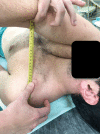Comparison of the Medial And Lateral Rotations of the Shoulder Between Non-Athletes and Professional Squash Athletes
- PMID: 32346199
- PMCID: PMC7186066
- DOI: 10.1055/s-0039-3400524
Comparison of the Medial And Lateral Rotations of the Shoulder Between Non-Athletes and Professional Squash Athletes
Abstract
Objective To compare the medial and lateral rotations of the shoulders and the distances between the coracoid process and the cubital fossa of non-athletic individuals to those of elite squash players. Method The cross-sectional study was performed between March and August 2017. Male and female non-athletes ( n = 628) were selected at the Orthopedic Emergency Service of our institution. The inclusion criteria were: age between 18 and 60 years, no physical disabilities or cognitive impairments and absence of pain in the upper limbs. Elite squash players ( n = 30) of various nationalities were selected at an event held in our city. All of the athletes had practiced this sport under high performance requirements for > 10 years and/or 10.000 hours, and all were asymptomatic. Demographic and clinical data were collected through interviews, while physical examinations and shoulder assessments were performed by a single orthopedic practitioner. Results If compared with non-athletes, elite squash players presented significant ( p < 0.001) mean losses of 23°34' in medial rotation and significant ( p < 0.003) mean gains of 10°23' in lateral rotation of the dominant shoulders. There was a significant difference ( p < 0.008) between non-athletes and athletes regarding the distance between the coracoid process and the cubital fossa in the dominant arm. Conclusion Intensive squash practice causes adaptive changes that trigger glenohumeral medial rotation deficit, accompanied by significant lateral rotation gain, and can generate pathogenic alterations in the shoulder.
Keywords: range of motion; rotation; shoulder joint.
Conflict of interest statement
Conflito de Interesses Os autores declaram não haver conflito de interesses.
Figures




References
-
- Bigliani L U, Kelkar R, Flatow E L, Pollock R G, Mow V C. Glenohumeral stability. Biomechanical properties of passive and active stabilizers. Clin Orthop Relat Res. 1996;(330):13–30. - PubMed
-
- Bigliani L U, Codd T P, Connor P M, Levine W N, Littlefield M A, Hershon S J. Shoulder motion and laxity in the professional baseball player. Am J Sports Med. 1997;25(05):609–613. - PubMed
-
- Crockett H C, Gross L B, Wilk K E et al.Osseous adaptation and range of motion at the glenohumeral joint in professional baseball pitchers. Am J Sports Med. 2002;30(01):20–26. - PubMed
-
- Wilk K E, Macrina L C, Fleisig G S et al.Correlation of glenohumeral internal rotation deficit and total rotational motion to shoulder injuries in professional baseball pitchers. Am J Sports Med. 2011;39(02):329–335. - PubMed
-
- Abrams G D, Sheets A L, Andriacchi T P, Safran M R. Review of tennis serve motion analysis and the biomechanics of three serve types with implications for injury. Sports Biomech. 2011;10(04):378–390. - PubMed
LinkOut - more resources
Full Text Sources

